Abstract
Extensive experience with isotransplants of 27 different tumours (leukaemias, sarcomata, carcinomata), all of strictly spontaneous origin in laboratory bred mice of low cancer strains CBA/Ht and WHT/Ht, has revealed no evidence of tumour immunogenicity. Of approximately 20,000 maintenance transplants, none failed and none regressed; of almost 10,000 carefully observed tumours arising from small or minimal inocula of tumour cells, none spontaneously regressed. The number of injected viable tumour cells required to give a 50% probability of successful transplantation (the TD50) ranged from approximately 1 cell to greater than 10,000 cells among the 27 tumours; high TD50 values, which were dramatically reduced by various procedures having no immunological significance, did not signify active "resistance" of the hosts. In the case of all of 7 randomly selected tumours, prior "immunization" of recipients with homologous lethally irradiated cells increased their tumour receptivity. Several experiments using various tumours failed to give evidence that immunity could be non-specifically induced or that a massive preponderance of lymphocytes from specifically sensitized mice could inhibit tumour transplantation or growth in vivo; no trace of "resistance" to tumour was adopted by isogeneic recipients of lymphocytes from regional nodes of tumour bearers. A limited review of the recent literature on tumour immunity shows that practically all the animal data presented in support of a general theory of tumour immunogenicity or to provide a basis for active clinical immunotherapy have been obtained from transplanted tumour systems which entail artefactual immunity associated with viral or chemical induction of the tumours or their allogeneic transplantation. It is suggested that isotransplants of spontaneously arising tumours are the only appropriate models of human cancer and that any genuine rapport between the animal laboratory and the clinic requires their exclusive use.
Full text
PDF


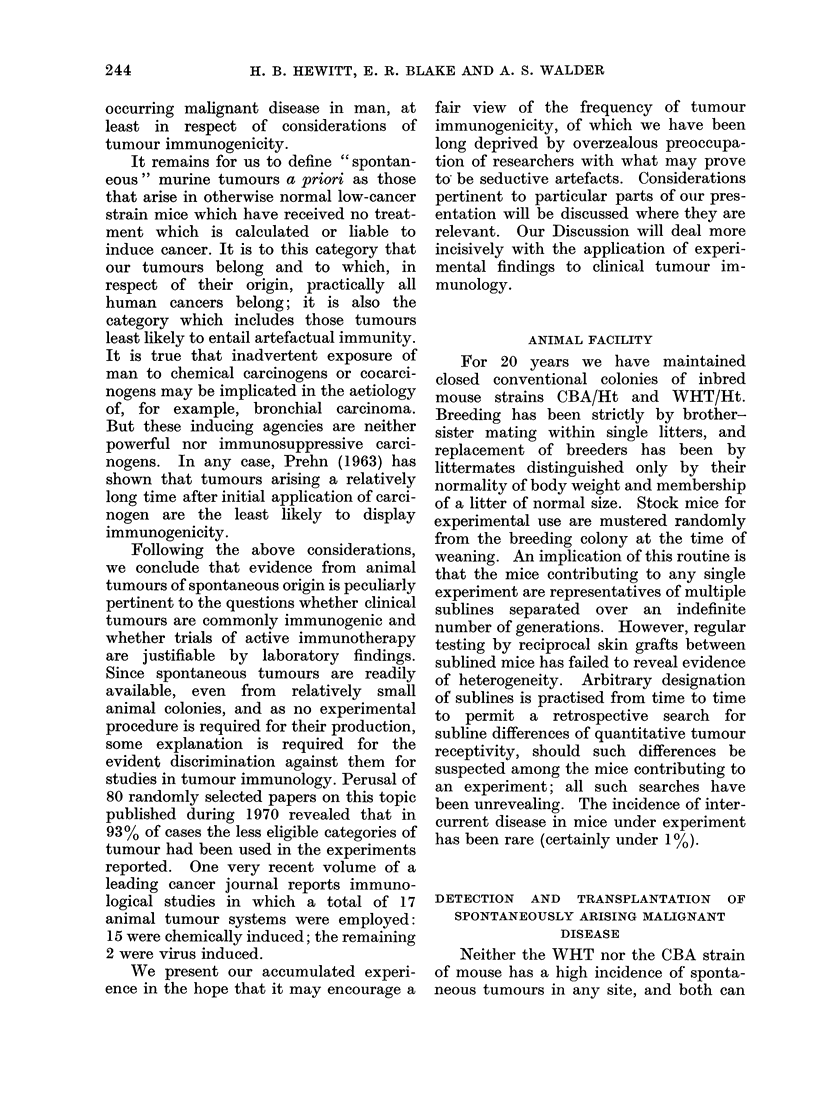
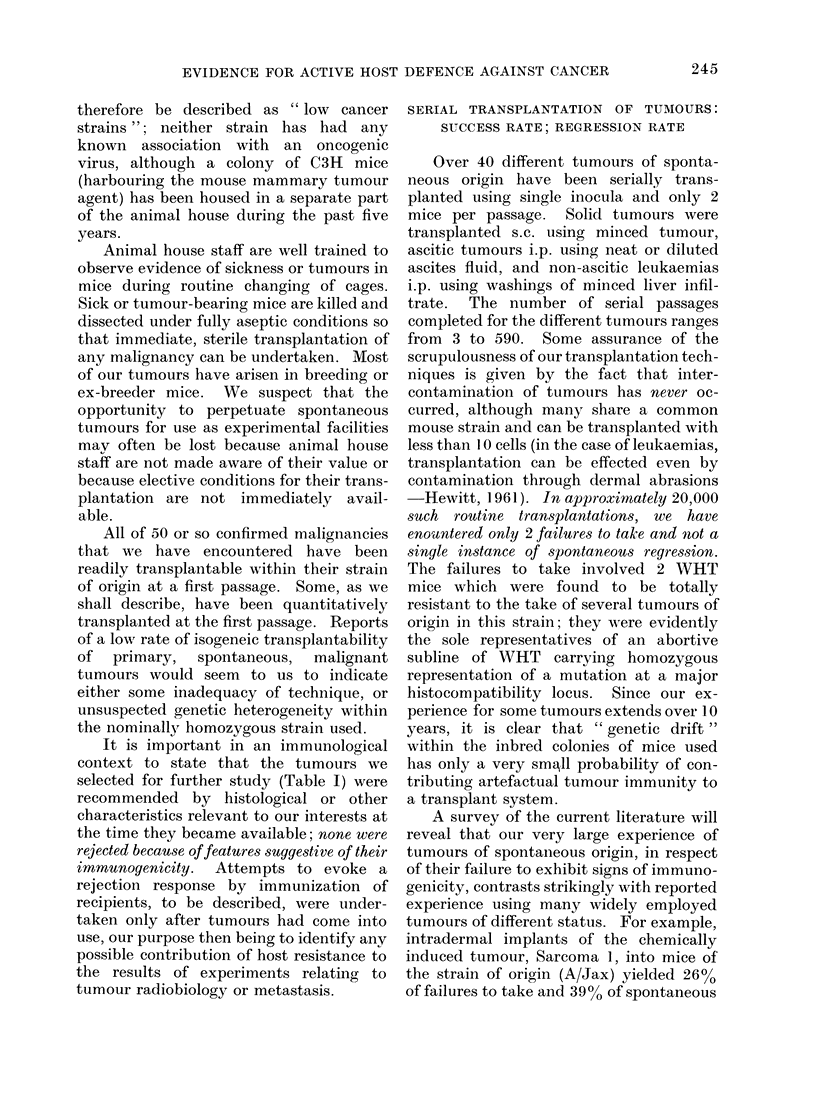






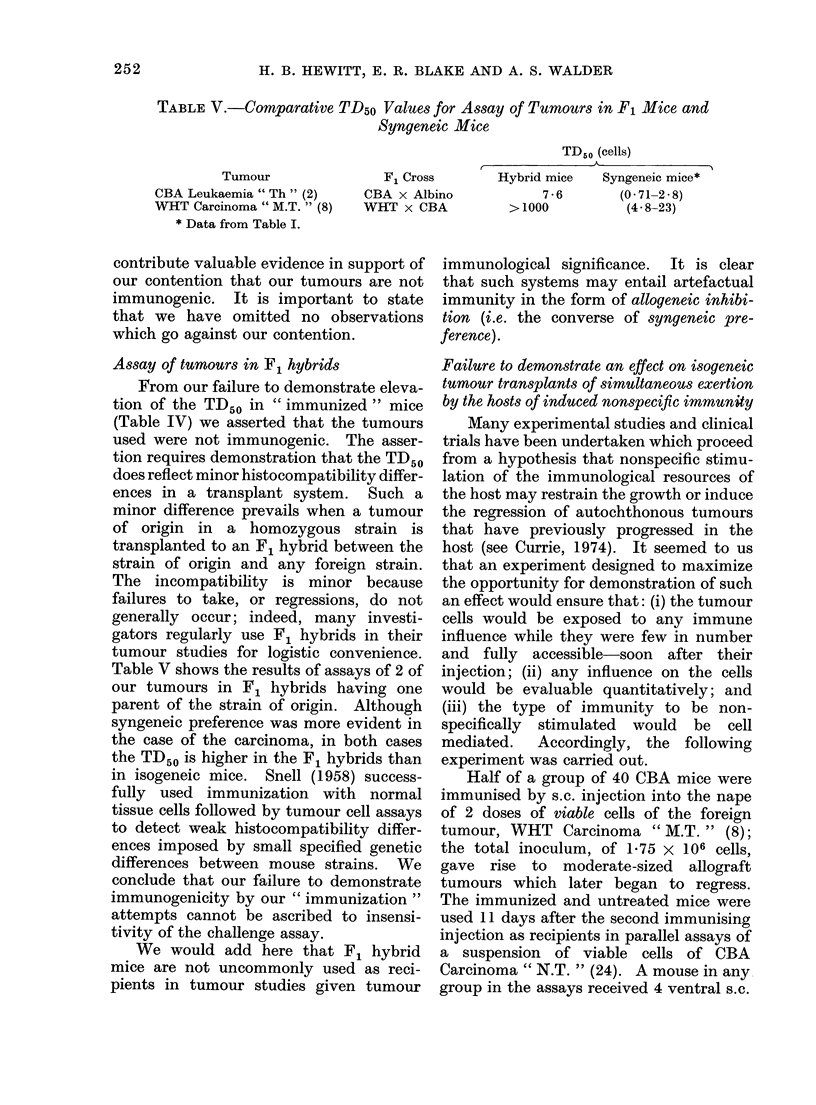
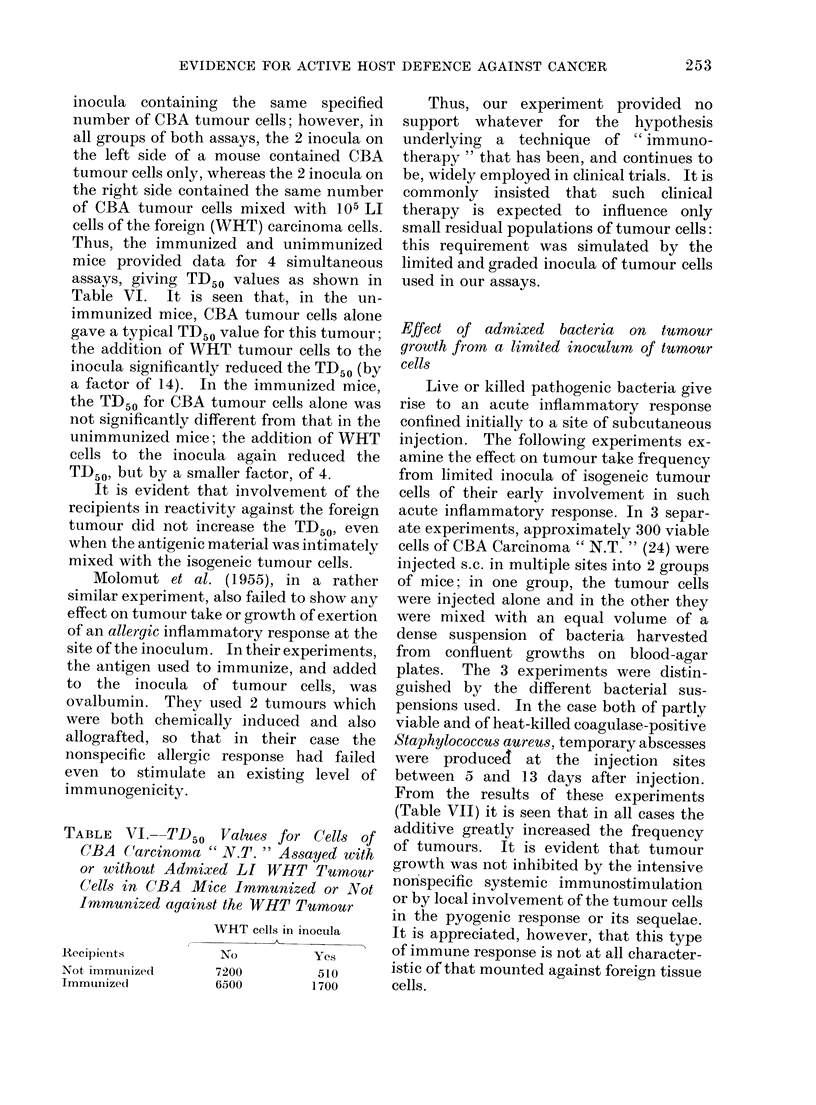
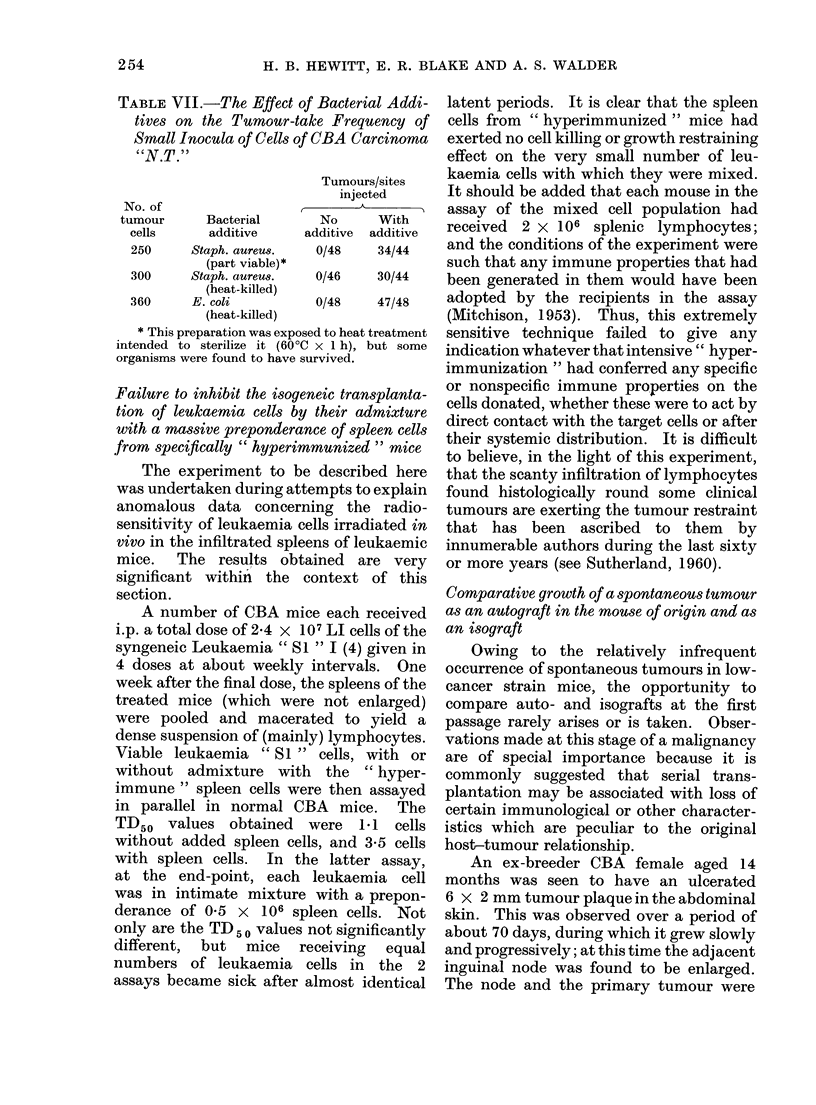





Selected References
These references are in PubMed. This may not be the complete list of references from this article.
- Amiel J. L., Berardet M. An experimental model of active immunotherapy preceded by cytoreductive chemotherapy. Eur J Cancer. 1970 Dec;6(6):557–559. doi: 10.1016/0014-2964(70)90078-2. [DOI] [PubMed] [Google Scholar]
- BERENBAUM M. C. EFFECTS OF CARCINOGENS ON IMMUNE PROCESSES. Br Med Bull. 1964 May;20:159–164. doi: 10.1093/oxfordjournals.bmb.a070311. [DOI] [PubMed] [Google Scholar]
- Baldwin R. W., Pimm M. V. BCG immunotherapy of rat tumors of defined immunogenicity. Natl Cancer Inst Monogr. 1973 Dec;39:11–19. [PubMed] [Google Scholar]
- COLLINS V. P., LOEFFLER R. K., TIVEY H. Observations on growth rates of human tumors. Am J Roentgenol Radium Ther Nucl Med. 1956 Nov;76(5):988–1000. [PubMed] [Google Scholar]
- CRILE G., Jr RATIONALE OF SIMPLE MASTECTOMY WITHOUT RADIATION FOR CLINICAL STAGE 1 CANCER OF THE BREAST. Surg Gynecol Obstet. 1965 May;120:975–982. [PubMed] [Google Scholar]
- Crowther D., Powles R. L., Bateman C. J., Beard M. E., Gauci C. L., Wrigley P. F., Malpas J. S., Fairley G. H., Scott R. B. Management of adult acute myelogenous leukaemia. Br Med J. 1973 Jan 20;1(5846):131–137. doi: 10.1136/bmj.1.5846.131. [DOI] [PMC free article] [PubMed] [Google Scholar]
- Currie G. A. Active immunotherapy with Corynebacterium parvum and chemotherapy in murine fibrosarcomas. Br Med J. 1970 Feb 28;1(5695):541–544. doi: 10.1136/bmj.1.5695.541. [DOI] [PMC free article] [PubMed] [Google Scholar]
- Currie G. A. Eighty years of immunotherapy: a review of immunological methods used for the treatment of human cancer. Br J Cancer. 1972 Jun;26(3):141–153. doi: 10.1038/bjc.1972.21. [DOI] [PMC free article] [PubMed] [Google Scholar]
- FOLEY E. J. Antigenic properties of methylcholanthrene-induced tumors in mice of the strain of origin. Cancer Res. 1953 Dec;13(12):835–837. [PubMed] [Google Scholar]
- HADDOW A., ALEXANDER P. AN IMMUNOLOGICAL METHOD OF INCREASING THE SENSITIVITY OF PRIMARY SARCOMAS TO LOCAL IRRADIATION WITH X RAYS. Lancet. 1964 Feb 29;1(7331):452–457. doi: 10.1016/s0140-6736(64)90793-7. [DOI] [PubMed] [Google Scholar]
- HEWITT H. B. Studies of the dissemination and quantitative transplantation of a lymphocytic leukaemia of CBA mice. Br J Cancer. 1958 Sep;12(3):378–401. doi: 10.1038/bjc.1958.47. [DOI] [PMC free article] [PubMed] [Google Scholar]
- HEWITT H. B. Transplantation of murine leukaemia by unconventional routes. Nature. 1961 Sep 16;191:1213–1214. doi: 10.1038/1911213a0. [DOI] [PubMed] [Google Scholar]
- Hewitt H. B., Blake E., Proter E. H. The effect of lethally irradiated cells on the transplantability of murine tumours. Br J Cancer. 1973 Aug;28(2):123–135. doi: 10.1038/bjc.1973.130. [DOI] [PMC free article] [PubMed] [Google Scholar]
- Hewitt H. B., Blake E. Quantitative studies of translymphnodal passage of tumour cells naturally disseminated from a non immunogenic murine squamous carcinoma. Br J Cancer. 1975 Jan;31(1):25–35. doi: 10.1038/bjc.1975.4. [DOI] [PMC free article] [PubMed] [Google Scholar]
- Hewitt H. B. The effect on cell survival of inhalation of oxygen under high pressure during irradiation in vivo of a solid mouse sarcoma. Br J Radiol. 1966 Jan;39(457):19–24. doi: 10.1259/0007-1285-39-457-19. [DOI] [PubMed] [Google Scholar]
- Klein G. Immunological factors affecting tumour growth. Br Med J. 1970 Nov 14;4(5732):418–418. doi: 10.1136/bmj.4.5732.418. [DOI] [PMC free article] [PubMed] [Google Scholar]
- MOLOMUT N., SPAIN D. M., KREISLER L., WARSHAW L. J. The effect of an allergic inflammatory response in the tumor bed on the fate of transplanted tumors in mice. Cancer Res. 1955 Mar;15(3):181–183. [PubMed] [Google Scholar]
- PREHN R. T. FUNCTION OF DEPRESSED IMMUNOLOGIC REACTIVITY DURING CARCINOGENESIS. J Natl Cancer Inst. 1963 Oct;31:791–805. [PubMed] [Google Scholar]
- PREHN R. T., MAIN J. M. Immunity to methylcholanthrene-induced sarcomas. J Natl Cancer Inst. 1957 Jun;18(6):769–778. [PubMed] [Google Scholar]
- Pearson J. W., Pearson G. R., Gibson W. T., Chermann J. C., Chirigos M. A. Combined chemoimmunostimulation therapy against murine leukemia. Cancer Res. 1972 May;32(5):904–907. [PubMed] [Google Scholar]
- Perez C. A., Stewart C. C., Palmer-Hanes L. A., Powers W. E. Role of the regional lymph nodes in the cure of a murine lymphosarcoma. Cancer. 1973 Sep;32(3):562–572. doi: 10.1002/1097-0142(197309)32:3<562::aid-cncr2820320308>3.0.co;2-b. [DOI] [PubMed] [Google Scholar]
- Peters L. J. Enhancement of syngeneic murine tumour transplantability by whole body irradiation--a non-immunological phenomenon. Br J Cancer. 1975 Mar;31(3):293–300. doi: 10.1038/bjc.1975.64. [DOI] [PMC free article] [PubMed] [Google Scholar]
- Peters L. J., Hewitt H. B. The influence of fibrin formation on the transplantability of murine tumour cells: implications for the mechanism of the Révész effect. Br J Cancer. 1974 Apr;29(4):279–291. doi: 10.1038/bjc.1974.68. [DOI] [PMC free article] [PubMed] [Google Scholar]
- Porter E. H., Hewitt H. B., Blake E. R. The transplantation kinetics of tumour cells. Br J Cancer. 1973 Jan;27(1):55–62. doi: 10.1038/bjc.1973.7. [DOI] [PMC free article] [PubMed] [Google Scholar]
- Powers W. E., Palmer L. A., Tolmach L. J. Cellular radiosensitivity and tumor curability. Natl Cancer Inst Monogr. 1967 Feb;24:169–185. [PubMed] [Google Scholar]
- Rous P. Viruses and tumour causation. An appraisal of present knowledge. Nature. 1965 Jul 31;207(996):457–463. doi: 10.1038/207457a0. [DOI] [PubMed] [Google Scholar]
- SMITHERS D. W. An attack on cytologism. Lancet. 1962 Mar 10;1(7228):493–499. doi: 10.1016/s0140-6736(62)91475-7. [DOI] [PubMed] [Google Scholar]
- SNELL G. D. Histocompatibility genes of the mouse. I. Demonstration of weak histocompatibility differences by immunization and controlled tumor dosage. J Natl Cancer Inst. 1958 Apr;20(4):787–824. [PubMed] [Google Scholar]
- Simmons R. L., Rios A. Comparative and combined effect of BCG and neuraminidase in experimental immunotherapy. Natl Cancer Inst Monogr. 1973 Dec;39:57–68. [PubMed] [Google Scholar]
- Smith S. E., Scott M. T. Biological effects of Corynebacterium parvum. 3. Amplification of resistance and impairment of active immunity to murine tumours. Br J Cancer. 1972 Oct;26(5):361–367. doi: 10.1038/bjc.1972.47. [DOI] [PMC free article] [PubMed] [Google Scholar]
- Snell G. D. Immunologic enhancement. Surg Gynecol Obstet. 1970 Jun;130(6):1109–1119. [PubMed] [Google Scholar]
- Suit H. D., Kastelan A. Immunologic status of host and response of a methylcholanthrene-induced sarcoma to local x-irradiation. Cancer. 1970 Jul;26(1):232–238. doi: 10.1002/1097-0142(197007)26:1<232::aid-cncr2820260129>3.0.co;2-d. [DOI] [PubMed] [Google Scholar]
- Suit H. D., Sedlacek R., Wagner M., Orsi L. Radiation response of C3H fibrosarcoma enhanced in mice stimulated by Corynebacterium parvum. Nature. 1975 Jun 5;255(5508):493–494. doi: 10.1038/255493a0. [DOI] [PubMed] [Google Scholar]
- Szakal A. K., Hanna M. G., Jr Immune suppression and carcinogenesis in hamsters during topical application of 7,12-dimethylbenz(a)anthracene. Natl Cancer Inst Monogr. 1972 Dec;35:173–182. [PubMed] [Google Scholar]
- Van den Brenk H. A., Sharpington C., Orton C. Macrocolony assays in the rat of allogeneic Y-P388 and W-256 tumour cells injected intravenously: dependence of colony forming efficiency on age of host and immunity. Br J Cancer. 1973 Feb;27(2):134–152. doi: 10.1038/bjc.1973.18. [DOI] [PMC free article] [PubMed] [Google Scholar]


